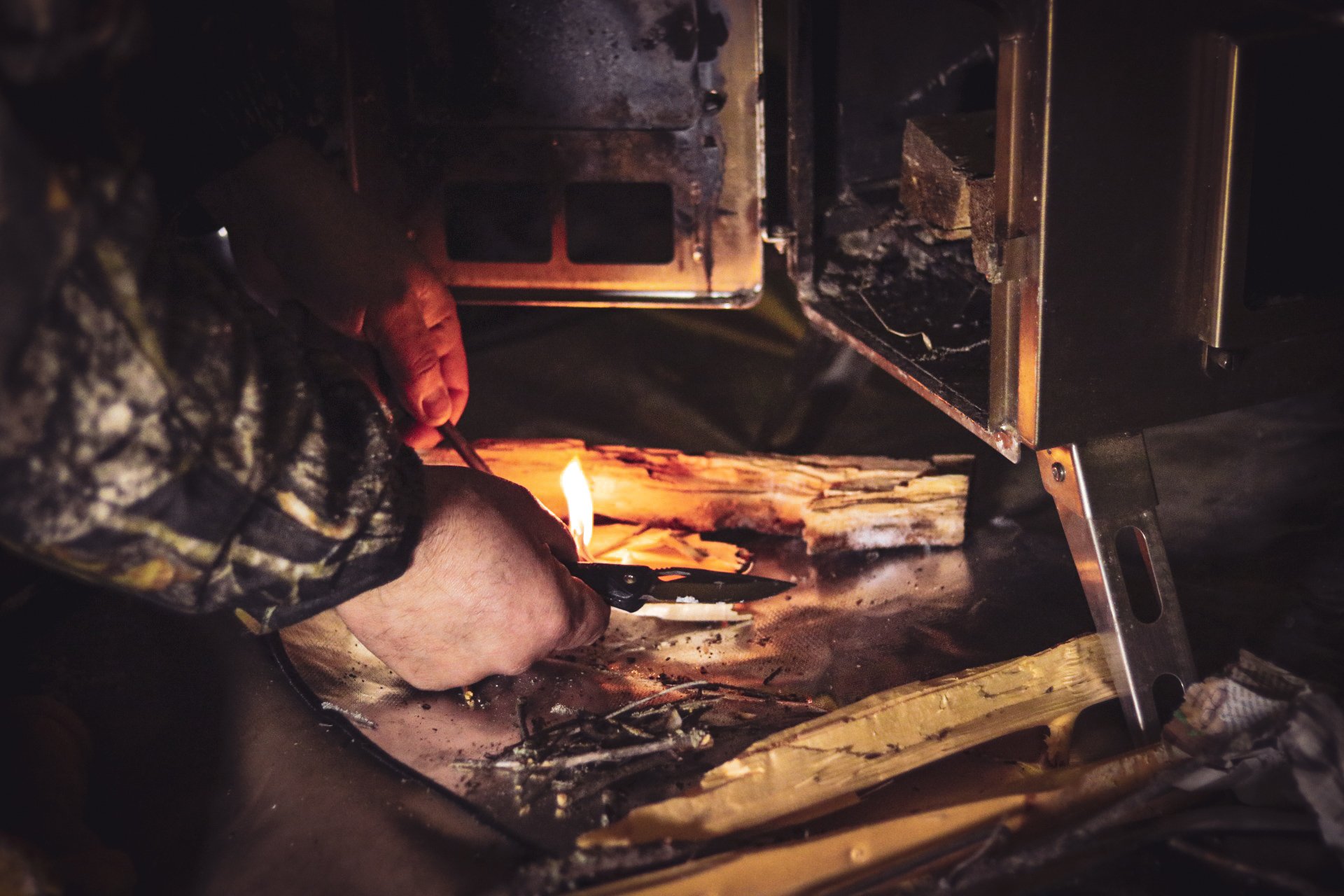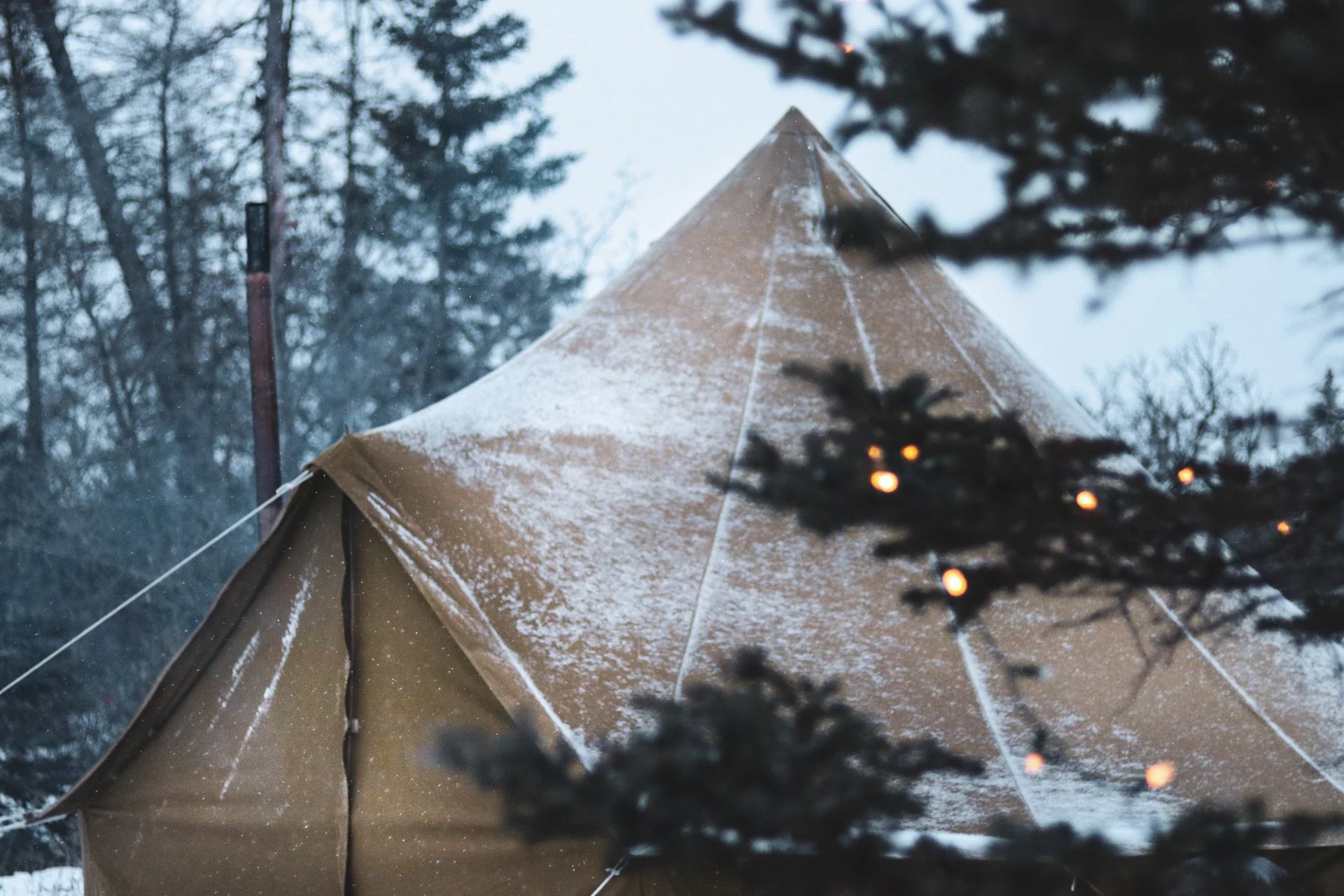Operating a tent stove properly takes practice (and a little patience). But once you nail it, knowing how to create and maintain a fire in the wild—not to mention inside your incredible canvas tent—is pretty badass 😏
A well-functioning wood stove relies on these three things:
- Proper installation
- Proper operation
- Proper maintenance
Here, we break down each step of these tent-stove essentials so that anyone can master the art of wood stoves. First, let’s talk about seasoning your stove.
How to Season your Stove for Camping
Before setting up your stove in your tent, we always recommend using your stove outside first—your backyard or a park will do. Seasoning helps to cure the stove to limit any potential off-gassing inside your tent and to set the material in place to prevent smoke from seeping out. Seasoning also allows you to nail your fire-starting technique and optimize burning temperatures and burn rates using the airflow control. This outdoor practice round will also ensure that you are using your stove safely. Jump to our How to Use Your Tent Stove Properly instructions below for 🔥 tips.
How to Instal Your Stove in Your Canvas Tent
CanvasCamp intentionally designs their tents without a pre-installed hole and stove jack. By installing a modular stove jack yourself, you have way more flexibility in terms of the type of stove you use, where you position the stove and the way you vent your stove.
1. Choose the Ideal (and Safest) Spot for your Tent Stove
First things first: plan the layout inside your tent and where your stove best fits within that plan. What size of bed(s) will you have, and where will it (they) go? What other furniture do you want? What gear do you need to store?
And while feng shui is a consideration, you also need to consider your heating requirements which will depend on the season(s) you intend to camp and the climate you’re camping in. As we cover in our 101 article on tent stoves, if you’re looking at a portable stove and keen on camping in the height of Canadian winters, you’re going to want to place your tent stove closer to the middle of the tent. That centre placement is especially important if it’s a portable stove with limited output, as it will distribute the heat more evenly, creating a hot-tent effect from both the stove and the ambient heat off the flue kit.
Portable tent stoves—like the Winnerwell Woodlander and Winnerwell Nomad—typically have vertical exits to maximize heat output from both the stove and the radiant heat from the flue kit. You can do the same with our Bison Stove with a couple of extra pipe sections; though these puppies are so powerful, they can sit closer to the sidewalls and have the same effect.
Finally, always leave sufficient distance between the heat source and your gear ⚠️ In general, you want to place the stove three or more feet from the tent sidewalls and roof and six or more feet between the stove and the top of the chimney. When using one of our modular stove jacks, make sure you leave at least four feet between the stove and the exit to prevent the jack from overheating (and, god forbid, melting).
2. Instal the stove jack properly (if needed).
Unless you are venting horizontally through the window (which you can absolutely do, just make sure you are using an insulated flue pipe), you will need to install a stove jack. Check out our Tent Stove 101, which covers how to install a modular stove jack.
Warning: this advice only applies to our tents and stoves; we cannot provide advice on any third-party products. Be prudent in these cases by using both a jack and a double-wall stove pipe.
How to Use Your Tent Stove Properly
We put together some hot tips gathered from the team at Winnerwell Stoves as well as fellow Citizen, Will Harrison (@bushcraft.canadian).
1. Burn hardwood in your tent stove.
Hardwoods burn clean and last a lot longer than softwoods. Softwoods can create smoke and embers that can burn a hole in your tent. That said, we get that the price of lumber is volatile and that hardwood isn’t always readily available (even in Canada). So if you must use softwood, ensure it's been properly seasoned by stacking it and drying it out before use (ideally, you want less than 20% moisture to prevent creosote buildup which causes smoke).
2. Create a hotbed of coals.
When starting your fire, it’s important to quickly establish a hotbed of coals to initiate a strong draw of air through the stove and up the flue. Use a good amount of small tinder when starting a fire in the tent stove - while keeping the airflow control open, slowly adding larger pieces of wood. Never start a fire using flammable accelerates such lighter fluid.
3. Don’t overload the wood stove.
Avoid using too much wood, as this can create excessive heat, which can warp or damage the stove.
4. Don’t stir the coals in the stove.
If so, you may create sparks and burn the tent.
5. Always open the stove door slowly.
Opening the tent stove door cautiously will prevent smoke spillage into your tent or shelter. Make sure the airflow control is open before opening the door so that the smoke leaves through the chimney and not your tent.
6. Monitor smoke to check tent stove efficiency.
Your stove needs to burn hot enough to combust the wood efficiently. Your stove is operating efficiently if there is little to no visible smoke exiting the chimney pipe. On the contrary, if the chimney is belching visible smoke, this is an indication that the stove is not burning efficiently.
A smoky tent stove is almost always a result of poor ventilation, which can be prevented by following the steps above. It could also be because you haven’t stayed on top of maintaining your stove (see our guide below). And as you’ve likely heard us say before, a taught tent is a well-performing tent; a loose tent can draw air and smoke into the tent.
Your Go-to Tent Stove Maintenance Guide
Proper maintenance of your stove is just as important—if not more important—as proper operation of your stove. Wood stove maintenance and safety go hand in hand.
Here are three quick ways to maintain your stove after each and every fire:
1. Scrape any remaining ash out of the firebox.
2. Using a pipe brush, remove all creosote (you know, that black, sticky by-product from burning plant-based materials) from the pipes, as carbon monoxide could start building up in the tent.
3. Clean the spark arrestor to avoid clogging it and smoking up your tent.
If you plan to use your tent stove often, e.g. if you run a guest-stay business in the shoulder and winter season—we recommend applying a non-toxic fire retardant such as Fire Block. This treatment forms a thermal insulation barrier that prevents dangerous flames from spreading, while inhibiting the development of toxic hydrocarbon smoke.
What to Pack
- A carbon monoxide monitor to keep you and your family safe
- A fire extinguisher to put out any unruly fires (we don’t expect that to happen if you follow the instructions above, but better safe than sorry)
- Heat resistant gloves to prevent burning yourself (especially when you’re groggy at night refueling the fire)
- A pipe brush to clean the pipes post fire
- A fiberglass fireproof mat to protect the base of your tent
Plus a couple of nice to haves:
- A stove thermometer to keep heat output consistent and to monitor overheating
- A stove fan to distribute the heat throughout your tent.
Now you’re ready to light it up. Have fun, stay cozy, and remember: never, ever, leave your stove unattended.

Big thanks to our pals at @woodside.trailhorse.co in Holland, MB, for all the beauty images used in this story. Check out the full Reel of their weekend in the woods 👀




